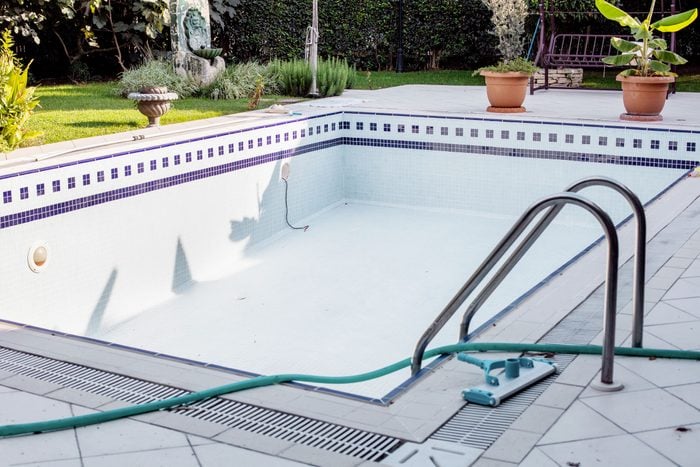How To Drain a Pool
Updated: Nov. 16, 2022

If you live in a cold climate, you may need to partially drain your pool in the winter. Here's how to drain a pool for passive winterization.
Imagine opening the tap and watching those thousands of gallons of in-ground pool water drain away. What a costly, wasteful undertaking, right? Fortunately for most pool owners, completely draining an in-ground pool is something they’ll never have to do.
But for in-ground pool owners in cold climates, partial draining is necessary for winterizing a pool. Here’s a look at when you might need to let some of the water out.
On This Page
Why Should You Drain Your Pool?
Ask almost any pool professional if you should completely empty your in-ground pool, and the answer will be a resounding no.
“I never recommend a full drain of any swimming pool unless you are being advised by a pool professional,” says John Bodden, an operations support advisor for America’s Swimming Pool Company (ASP). “Totally draining a pool should be done only for repairs and only a last option.”
Without the weight of the water to stabilize it, Bodden says, the pool walls could collapse, or the pool will pop out of the ground. But draining an in-ground pool isn’t an all-or-nothing task, at least not in normal circumstances.
In areas where temperatures routinely drop below 41 degrees, draining some water as part of passive winterization will help protect the structure, pipes and equipment from freeze damage. It also prevents the potential for overflow should the pool water freeze and expand.
How To Drain an In-Ground Pool
When you drain an in-ground pool for passive winterization, you lower the waterline to just below the skimmer level and flush water from the pipes. The key is not taking out so much water that you compromise the pool structure. Bodden outlines the following steps:
- With the pool system off, open your backwash valve (or drain line if you have one).
- Close off all skimmer lines with a plug or the valve(s) on the suction side of the pump.
- Ensure you’ll be drawing water from only the main drain (if equipped).
- Turn on the pool pump to begin lowering the water level.
- Once the water level is below the skimmer inlet, shut down the pump and equipment.
- Make sure to shut off all pool equipment and light breakers so low water levels don’t damage any equipment.
At this point, most cold-climate pool owners cover their pool for the winter. It can be a ready-made cover to fit your particular pool, or a heavy-duty tarp held in place with water bags. Be sure to keep snow from accumulating, melting and freezing on top of your pool cover. Remove fresh snow with a leaf blower or long-handled, wide push broom.
You can also install a pool air pillow under the cover. This creates a bow in the middle of the pool so snow will roll off instead of accumulating. Another option: A pool cover pump that activates when there’s water on top of the cover.
Bodden says before you start, check with your local municipality about where you can drain all that pool water. It may not allow chlorinated or salt pool water into flood or street drains.
And draining into your own yard isn’t necessarily a safe option. The water might harm your lawn and some trees. Not to mention, it may be bad for birds, small animals and beneficial insects that call your lawn home.
“A pool professional can advise you on these questions,” says Bodden.
How Much Does It Cost To Drain a Pool?
If you DIY, the costs are minimal. Bodden says some in-ground pools lack systems for backwash or self-draining, so you’ll need a submerged pump attached to a garden hose.
If you hire a pro, expect to pay around $115 per hour for what usually amounts to a couple of hours of work.
